How to Cook Steamed Rice without a Rice Cooker
This article will explain how you can cook steamed rice at home in the Korean style without an electric rice cooker. If you landed on this page through a search engine, you may want to start with our Korean Food Intro page. Also, our Recipes page has 25 recipes for Korean foods, many of which you can enjoy along with your ordinary American meal, without necessarily having to cook steamed rice.
However, some of you may want to delve a bit deeper into the Korean food culture and simulate a Korean dinner table more closely. For that, you would need to make steamed white rice. With an electric rice cooker, all you need to do is press the button. But most of our readers probably cook Korean food occasionally and don’t have such an appliance. Steamed rice had been cooked for centuries and centuries before the advent of microprocessors, and you too can make perfect steamed rice in a pot, if you know the trick.
Before getting into the details, however, it's probably a good idea to provide you with a brief overview of rice in the Korean culture and how a traditional Korean dinner table looks like.
The Place of Rice in Korean Culture and Cuisine
Steamed rice is called “Bap” (밥 ) in Korean. In the Korean language, however, this same word also means “meal”. For example, the expression “밥 먹을 시간이 없다 ” (literal translation: “I have no time to eat steamed rice”) means “I have no time to have a meal.” As rice has reigned supreme in Korean cuisine, all other foods on the table are, no matter how fancy they may be, considered auxiliary or “companions of steamed rice”.
Korean Table Setting
A Korean home meal consists of:
a bowl of steamed rice (밥 : Bap) – per person
a bowl of soup (국 : Guk) – (optional) per person – placed next to the rice bowl. Unlike soups in Western cuisines, Korean soups stay on the table from the beginning to the end of the meal.
side dishes (반찬 : Banchan) – a number of side dishes on the table, which are shared by all.
Each of the side dishes is called a “Banchan”. In an everyday Korean meal, no single Banchan stands out – all the Banchans have more or less the same importance. But, from time to time, a special soup or a special Banchan is included as a kind of le plat du jour (the dish of the day). Even then, the most important thing of the meal, in the traditional Korean setting, is always the steamed white rice, and le plat du jour is supposed to play a supporting (albeit special) role.
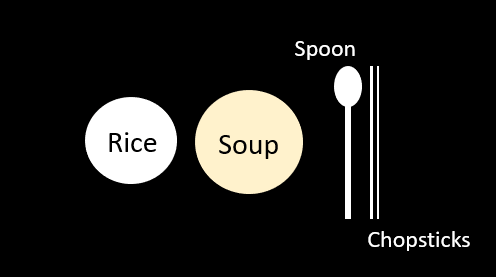
Per-person setting on a Korean table. Side dishes are not shown. Placed in front of each person are (from left to right): a bowl of rice, a bowl of soup, a spoon and chopsticks. Both the spoon and the chopsticks are placed on the right side. When you enjoy Korean food along with your American meal, you would probably need a fork and a knife as well. Koreans use metallic chopsticks and spoons (made of stainless steel or silver). The lacquered, reusable wooden chopsticks you might have seen in Japanese restaurants are generally not used in Korea; the only wooden chopsticks used are disposable chopsticks. Also, the porcelain soup spoons used in some Asian restaurants in the United States are not used in Korea.
Cooking Steamed Rice in a Pot
Type of Rice
Korean cuisine calls for rice that is relatively short in grain length. The official name for the Korean-style rice is “medium grain rice”. American grocery chains carry “long grain” and “extra-long grain” rice. These are slightly less sticky than Korean-style “medium grain”, but they are otherwise very similar and perfectly fine for Korean cooking. In fact, most of our readers won’t notice a big difference in grain shape or taste. On the other hand, the needle-thin, fluffy rice is not a good choice for Korean cooking.
Korean grocery stores sell many types of “medium grain” (Korean style) rice. Most are ordinary white rice, but some are brown rice (with the germ portion remaining uncut on each grain); some are even husked rice (each grain still retains the husk; you need a small dehusking machine at home); and some are sweet rice, a different variety used for special purposes for its stickiness. If you can’t read the Korean writing on the packages, you may need assistance in choosing the right rice in a Korean grocery. Or, as far as rice is concerned, you may find it simpler to just pick up a bag of “long grain” or “extra-long grain” rice at an American supermarket.
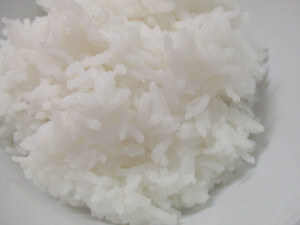
Steamed rice made with “long grain” rice purchased from an American supermarket
Amount Needed
For 2 people, take out about 1.5 cups of rice (or slightly less than that) from the bag and put it in a pot.
Looking for Contaminants
It’s always a good idea to briefly sift through the rice to look for any contaminants. Occasionally, you will see 1-2 unpeeled rice grains with the yellow husk still on (those are not harmful but remove them). Although very rare, you might find a piece of “stone”, which can damage your teeth if you bite on it. Quickly sift through the rice with your fingers to look for any such “stone” pieces. It only takes 10 seconds to do that, and this “examination” can be done before adding water or during the washing step.
Washing
Add cold water into the pot containing the rice. Briefly swirl and discard the water by decanting. You don’t need to remove the water completely – just a quick decanting is sufficient. Repeat once and discard the water. This step will remove most of the fine rice powder generated during milling.
Soaking
Add 2.5 cups of fresh cold water to the washed rice in the pot. With this amount of water added, you will notice that there is an extra depth of water above the top layer of rice (in other words, the rice is flooded). Let it sit for at least 20 minutes (or, up to a couple of hours, if you’re busy doing other things in the kitchen). The measurement of water given here is only approximate, and you will see why a precise measurement is unnecessary, when you read the passages below.
Cooking
(i) Initial Boiling: Place the pot containing the rice and water on your kitchen range and start the heat at high. As the water in the pot boils, initially it would be nearly impossible to cover the pot with a lid, because a lot of starch bubbles will vigorously rise up. These bubbles will eventually subside, but you need to stand by the pot until then. Keep boiling the water with the pot uncovered for a few minutes. During this step, the water level will be reduced due to evaporation. It’s very important that you stand by the pot and constantly monitor the water level, which is rapidly reduced as time goes by. About 3-5 minutes after the water was first brought to full boil, the extra depth of water above the rice (the “flood” water, which was there to begin with) will have mostly evaporated but there is still some residual water surrounding the individual rice grains at the top layer of the rice. At this point, reduce the heat to medium high and cover the pot with a lid.
(ii) Heating at Medium High Heat: Continue heating with the pot covered. Starch bubbles may still rise up occasionally. If the bubbles spill over, it’s okay to open the lid just for 1 second to ventilate (to let the bubbles subside). Continue for about 5 minutes at this heat setting. It’s important to keep the pot covered as much as possible (to get “steamed rice”, rather than “boiled rice”).
(iii) Gentle Steaming (this is the most important step, determining the quality of the steamed rice): Reduce the heat further to medium-low so that the pot can be maintained in a steady simmering condition (where a gentle stream of steam is leaking out). Continue at this heat setting for about 15 minutes. It’s important to keep the pot covered. After the 15 minutes is up, turn off the heat. You can serve the rice now or leave the pot over the turned-off heat coil for up to about 10 minutes, if you want to keep it warm.
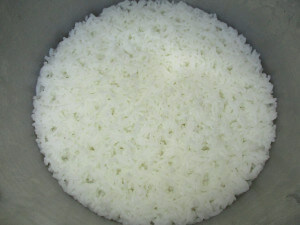
Steamed rice cooked in a pot, at the end of the cooking steps
A pot with a glass lid will make it easier for you to monitor the water level (or moisture) in the pot without opening the lid, but it’s not strictly necessary. Also, if you use a tall pot rather than a wider, flatter pot, you don’t have to struggle as much with the rising starch bubbles, because the bubbles tend to cool down as they crawl up the wall of the pot.
Some people prefer more “moist” steamed rice, while others like “firmer” steamed rice. By adjusting the heat settings (heating profile), you can find the right moisture level you like, with trial and error. You may not be able to find the optimal heat settings at your very first trial. If you notice a burning smell, it means that too much water has evaporated at the high or medium high heat steps.
Even when you need steamed rice just for 1 person, you still want to start with the amount of rice and water suggested above (meant for 2 people), which is the practical minimum. If you cut down the scale any further, it’s difficult to get tasty steamed rice.
Noo-Roong-Ji (누룽지 )
Depending on how long your pot stayed over a relatively high heat, sometimes (if not always) you get a layer of golden-brown, hardened rice at the bottom of the pot, which Koreans call “Noo-roong-ji” (누룽지 ). Noo-roong-ji is not necessarily an unwanted byproduct. Some people love it so much that they deliberately induce the formation of Noo-roong-ji in the pot.
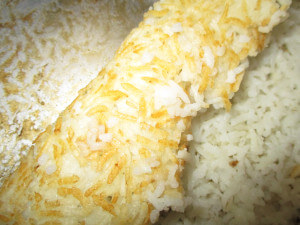
Noo-roong-ji, or hardened rice layer, formed at the bottom of a pot
If you got Noo-roong-ji, you can add some cold water to the pot and briefly scrape the bottom with a wooden spatula to dislodge it from the bottom. Boil the Noo-roong-ji in water for 5-10 minutes and you will get loosened Noo-roong-ji in a liquid that is milky in color. Some like this loosened, soupy Noo-roong-ji for its characteristic, roasted rice taste. The liquid portion of this soup has a separate name — it's called “Soong-nyoong” (숭늉 ).
Leftover Steamed Rice
You can store leftover steamed rice in the refrigerator for up to several days. When re-heated in a microwave oven, it will be just like freshly cooked steamed rice – you won’t notice any difference. Directions: Put steamed rice in a bowl, sprinkle about a tablespoon of water on it, and cover the bowl with plastic wrap. Important safety precautions: do not cover the bowl completely but leave one corner wide open for ventilation; always put the bowl on a plate before putting it into the microwave oven; grab the plate, not the bowl, after heating. Microwave for about 3 minutes. When you remove the plastic wrap, be careful not to get burned by the steam.
Rice Porridge (죽 : Jook / Juk)
Rice porridge is a dish that is soothing to the stomach, easy to swallow and easy to digest. For this reason, it is a typical “patient food" in Korea. But a lot of people love it as a light meal, and there are franchised restaurants in Korea specializing in Jook. Some people like plain Jook, made with rice and nothing else, for the subtle and pure taste. 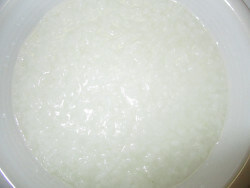 Others like a Jook with other ingredients such as pine nuts or abalone (a marine snail). Even if you are familiar with the taste of steamed rice, Jook will be yet another experience. The traditional method starts with uncooked rice grains and water. But it’s much easier if you start with pre-cooked steamed rice. (Making a Jook is similar to cooking steel cut oat, which requires frequent stirring. And the final appearance is also similar.)
Others like a Jook with other ingredients such as pine nuts or abalone (a marine snail). Even if you are familiar with the taste of steamed rice, Jook will be yet another experience. The traditional method starts with uncooked rice grains and water. But it’s much easier if you start with pre-cooked steamed rice. (Making a Jook is similar to cooking steel cut oat, which requires frequent stirring. And the final appearance is also similar.)
Directions: Leftover steamed rice stored in the refrigerator will be used in this "recipe" for Jook. In a pot, put 1 cup of pre-cooked steamed rice and 3 cups of cold water. (For the entire procedure, do not cover the pot with a lid.) At high heat, bring the mix to boil. Once boiling, reduce the heat to medium high and let it boil for about 15 minutes. Stir once and reduce the heat further to medium. Continue to cook it for an additional 10-15 minutes with frequent stirring, which prevents the rice from sticking to the bottom. When the rice is dissolved to form a thick, white porridge, turn off the heat and serve it hot.
You can enjoy it with no sauce or add a drop of soy sauce to each spoonful of Jook. If you want to eat Jook with a Banchan (side dish), one that goes very well with it is Beef Jorim with Soy Sauce (장조림 ; Jang Jorim), which is in our Recipes page.
There is a frequently used Korean expression related to Jook. “식은 죽 먹기” (“It’s like eating a bowl of cold Jook”) is an exact equivalent of the English expression, “a piece of cake.” Jook is easy to swallow, because there is nothing to chew on, but you need to be a bit careful when it’s hot. However, when Jook is cooled down, there is really no hindrance whatsoever. The expression means that the task under discussion can be easily accomplished with little efforts.